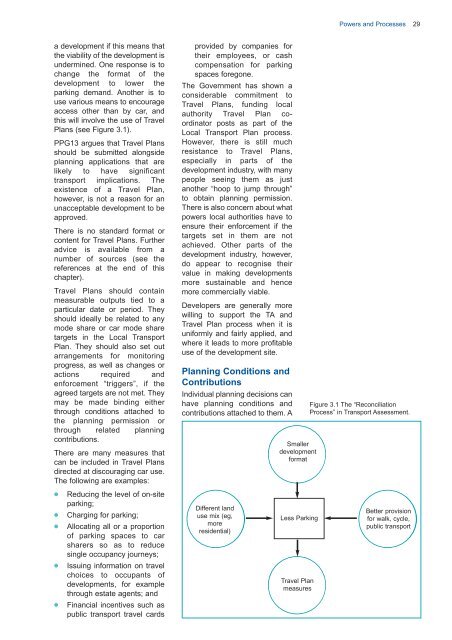titlepage/contents pg 1-16 - British Parking Association
titlepage/contents pg 1-16 - British Parking Association
titlepage/contents pg 1-16 - British Parking Association
Create successful ePaper yourself
Turn your PDF publications into a flip-book with our unique Google optimized e-Paper software.
Powers and Processes 29a development if this means thatthe viability of the development isundermined. One response is tochange the format of thedevelopment to lower theparking demand. Another is touse various means to encourageaccess other than by car, andthis will involve the use of TravelPlans (see Figure 3.1).PPG13 argues that Travel Plansshould be submitted alongsideplanning applications that arelikely to have significanttransport implications. Theexistence of a Travel Plan,however, is not a reason for anunacceptable development to beapproved.There is no standard format orcontent for Travel Plans. Furtheradvice is available from anumber of sources (see thereferences at the end of thischapter).Travel Plans should containmeasurable outputs tied to aparticular date or period. Theyshould ideally be related to anymode share or car mode sharetargets in the Local TransportPlan. They should also set outarrangements for monitoringprogress, as well as changes oractions required andenforcement “triggers”, if theagreed targets are not met. Theymay be made binding eitherthrough conditions attached tothe planning permission orthrough related planningcontributions.There are many measures thatcan be included in Travel Plansdirected at discouraging car use.The following are examples:provided by companies fortheir employees, or cashcompensation for parkingspaces foregone.The Government has shown aconsiderable commitment toTravel Plans, funding localauthority Travel Plan coordinatorposts as part of theLocal Transport Plan process.However, there is still muchresistance to Travel Plans,especially in parts of thedevelopment industry, with manypeople seeing them as justanother “hoop to jump through”to obtain planning permission.There is also concern about whatpowers local authorities have toensure their enforcement if thetargets set in them are notachieved. Other parts of thedevelopment industry, however,do appear to recognise theirvalue in making developmentsmore sustainable and hencemore commercially viable.Developers are generally morewilling to support the TA andTravel Plan process when it isuniformly and fairly applied, andwhere it leads to more profitableuse of the development site.Planning Conditions andContributionsIndividual planning decisions canhave planning conditions andcontributions attached to them. ASmallerdevelopmentformatFigure 3.1 The “ReconciliationProcess” in Transport Assessment.●●●Reducing the level of on-siteparking;Charging for parking;Allocating all or a proportionof parking spaces to carsharers so as to reducesingle occupancy journeys;Different landuse mix (eg,moreresidential)Less <strong>Parking</strong>Better provisionfor walk, cycle,public transport●Issuing information on travelchoices to occupants ofdevelopments, for examplethrough estate agents; andTravel Planmeasures●Financial incentives such aspublic transport travel cards







